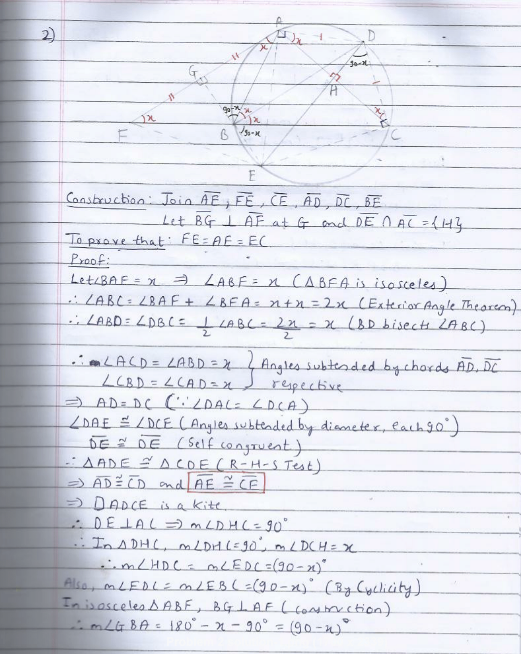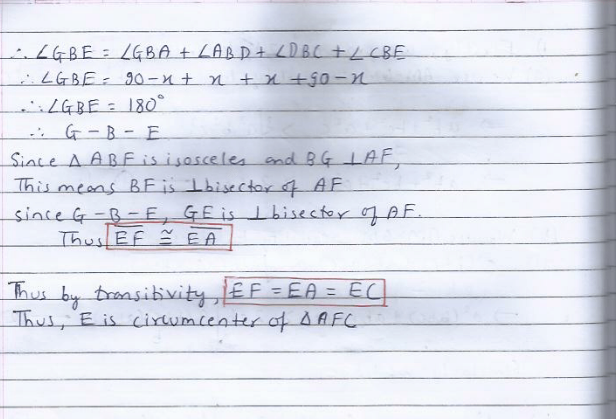RMO Online Mock Test - Results
So, RMO online mock test is completed.
Only 6 members had sent their solutions. So, here are the results.
So, Congratulations Nihar. You stood first.
Your prizes(ebooks) will be sent to your mail soon.
No vote yet
1 vote
Easy Math Editor
This discussion board is a place to discuss our Daily Challenges and the math and science related to those challenges. Explanations are more than just a solution — they should explain the steps and thinking strategies that you used to obtain the solution. Comments should further the discussion of math and science.
When posting on Brilliant:
*italics*or_italics_**bold**or__bold__paragraph 1
paragraph 2
[example link](https://brilliant.org)> This is a quote# I indented these lines # 4 spaces, and now they show # up as a code block. print "hello world"\(...\)or\[...\]to ensure proper formatting.2 \times 32^{34}a_{i-1}\frac{2}{3}\sqrt{2}\sum_{i=1}^3\sin \theta\boxed{123}Comments
Names of the ebooks prizes ? ( I guess you won't mind to reveal :) ).
Hey Guys I will just give you an easy solution to problem 2.
It can be easily observed that E is the midpoint of arc AC containing B. Let us drop a perpendicular N from E to on to BC. According to Archimedes Broken Chord Theorem, CN=BN+AB=BN+BF=FN. So, N is midpoint of CF. It implies that EN is perpendicular bisector of CF. Now, it is easy to prove that DE is perpendicular bisector of AC. As perpendicular bisectors of CF and AC i.e. EN and ED respectively meet at E. So, E is the circumcenter of ΔAFC.
Hence Proved.
Log in to reply
It would be better if you even mention proof to Archimedes broken chord.
Log in to reply
All I did was prove congruences and did a bit of angle chasing. My solution is longer but simpler.
Can you post the solutions to the first and the second questions?@Surya Prakash
Log in to reply
Yes I too want to see the solution for the second one.
Log in to reply
How many of the problems did you get?
Log in to reply
Tried the first 4 got 2.
I got all 6.
Thank you everyone :) Also thanks @Surya Prakash for holding this contest. Hope to see more challenging upcoming contests :)
Log in to reply
Congrats! Nihar Mahajan.You did best!
@Nihar Mahajan @Sharky Kesa @Shivam Jadhav @Siddharth Singh @Svatejas Shivakumar @Sarthak Behera
Log in to reply
Can we get our individual question marks and best solutions for each problem?
Congratulations! @Nihar Mahajan
Congratulations Nihar!!
Congrats nihar but want to ask you did you solve the paper in 3 hrs because I did .
Log in to reply
I did the first 5 questions in 2 hours. The 6th question required time though...
Log in to reply
Can you please post your solution for the second question?
Log in to reply
Sure.

Log in to reply
Can you post solution to 5,6 problem
Log in to reply
Q5)
Extend AI to meet the circumcircle of ΔABC at X, BI at Y and CI at Z. Note that ∠BAX=∠BCX and ∠CAX=∠CBX by cyclic bowties (Angles subtended by the same chord). Also, ∠BAX=∠CAX because AX is the angle bisector of ∠BAC. Therefore, ∠CBX=∠BCX, which implies ΔBXC is an isosceles triangle, which further implies BX=CX. Now, we have to prove BX=IX.
We have
∠XBI=∠XBC+∠CBI=∠XAC+∠CBI=∠IAC+∠CBI=21∠BAC+21∠ABC
Also,
∠XIB=∠IAB+∠IBA(∠XIB is the external angle of ΔAIB)=21∠BAC+21∠ABC
Thus, ∠XBI=∠XIB, which implies ΔXIB is isosceles, which implies XI=XB. We already know that XB=XC, so X is the circumcentre of ΔIBC. By definition, point X is on the circumcircle of ΔABC. Therefore, the circumcentre of ΔIBC lies on the circumcircle of ΔABC. Similarly, it can be proven that the circumcentre (Y) of ΔICA lies on the circumcircle of ΔABC and the circumcentre (Z) of ΔIAB lies on the circumcircle of ΔABC.
Log in to reply
I would not recommend my solution for Q6 since it is (a) 4 pages long and (b) Proves a massive generalisation.
Log in to reply
What!Really?!My solution is a page long!
Log in to reply
Log in to reply
@Shivam Jadhavcould you post the solution to the first one?
Log in to reply
ab(a+b)+ac(a+c)+bc(b+c)=2ab(a+b)+ac(a+c)+bc(b+c)+ab(a+b)+ac(a+c)+bc(b+c)=2a2(b+c)+b2(a+c)+c2(a+b)+(a2b+b2c+a2c)+(ab2+bc2+ac2)
By AM-GM inequality, ab2+bc2+ac2≥3abc
Therefore,
2a2(b+c)+b2(a+c)+c2(a+b)+(a2b+b2c+a2c)+(ab2+bc2+ac2)≥2a2(b+c)+b2(a+c)+c2(a+b)+(a2b+b2c+a2c)+3abc=2a2(b+c)+b2(a+c)+c2(a+b)+ab(a+c)+bc(a+b)+ac(b+c)
Grouping and again applying AM-GM inequality, (Applying AM-GM inequality on each term and adding all the terms)
2(a2(b+c)+ab(a+c))+2(b2(a+c)+bc(a+b))++2(c2(a+b)+ac(b+c))≥a3b(b+c)(a+c)+b3c(a+c)(a+b)+c3a(a+b)(a+c)=cyc∑abba(b+c)(c+a). Equality occurs when a=b=c
Hence proved.
Log in to reply
Woah!That is a big solution!Could you write the motivation please?
Congratulations @Nihar Mahajan !
@Surya Prakash Thank you very much for holding the content. When will the second one start?
Log in to reply
I can't say when because I am somewhat busy with preparation for NSEP.
I also want to participate insuch contests . Can any one suggest me the pathway and dates for future such contests
Thanks! to Surya Prakash for this opportunity.
Hey guys. The ebooks i.e. prizes are sent to the participants. Please check your mails.
When was it held?
@Surya Prakash Could u please conduct an INMO mock test similar to this ?